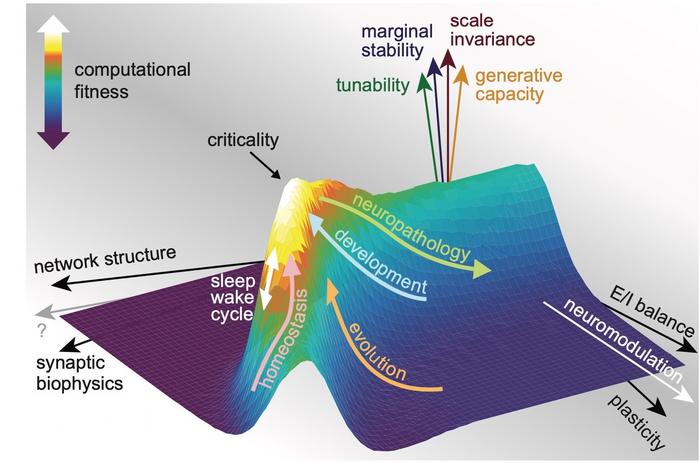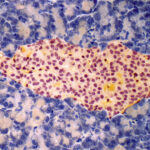
In the quest to unravel the enigmatic workings of the human brain, a groundbreaking theory is emerging that promises to reshape neuroscience and our approach to neurological diseases. According to Washington University in St. Louis associate professor Keith Hengen and physicist Woodrow Shew from the University of Arkansas, the brain’s extraordinary computational prowess stems from a singular, elegant principle: criticality. This concept—a delicate and dynamic balance between ordered and chaotic states—may serve as the brain’s universal setpoint, enabling its capacity for learning, memory, and cognition.
Criticality, a notion borrowed from physics, describes systems poised exactly at the tipping point of transformation, where they are neither too rigidly ordered nor too erratically disorganized. In tangible terms, consider a sandpile steadily accumulating grains until an avalanche occurs; just before the avalanche, the pile exists in a fine-tuned critical state, exquisitely sensitive to the addition of the next grain. When applied to brain function, this framework suggests that neural networks operate near this critical threshold to maximize computational effectiveness, striking a balance that optimizes information processing and adaptability.
Hengen elaborates that the brain does not rely on hardwired, fixed circuits for its remarkably versatile behaviors—such as language acquisition, driving, or playing instruments—but instead must maintain a capacity to learn continually throughout life. Achieving and sustaining criticality allows the collective dynamics of neurons to flexibly adjust and recalibrate in response to new stimuli and environments. At this razor’s edge, the brain attains its highest computational power, capable of integrating sensory input, forming memories, and generating complex cognitive functions.
.adsslot_1CRQmNAK59{width:728px !important;height:90px !important;}
@media(max-width:1199px){ .adsslot_1CRQmNAK59{width:468px !important;height:60px !important;}
}
@media(max-width:767px){ .adsslot_1CRQmNAK59{width:320px !important;height:50px !important;}
}
ADVERTISEMENT
The theory also offers an illuminating perspective on neurological diseases like Alzheimer’s, which traditionally have been conceptualized as resulting from localized cell death or protein abnormalities. Hengen shifts the focus to the brain’s global computational state, asserting that neurodegeneration is fundamentally a breakdown in criticality. As criticality wanes, the brain’s ability to process and adapt deteriorates long before symptoms such as memory loss become evident, thus explaining why early disease stages are often invisible to conventional clinical assessments.
This insight emerges from collaborations with experts such as David M. Holtzman, whose groundbreaking work connects the accumulation of tau protein—one of Alzheimer’s disease’s pathological hallmarks—to disruptions in brain criticality. The decay of criticality offers a mechanistic explanation linking molecular pathology to cognitive collapse. It suggests that interventions targeting the restoration of criticality might halt or even reverse early disease progression, representing a paradigm shift in therapeutic strategies.
A notable advancement of this theoretical framework is its testability. Using functional MRI (fMRI) technology, researchers have devised mathematical metrics to quantify how close a person’s brain operates to the critical point. This capability holds immense potential for early diagnosis, allowing clinicians to detect subtle deviations in brain function years before overt clinical symptoms manifest. Coupled with emerging blood-based biomarkers, this approach could revolutionize preemptive disease management.
Beyond the realm of disease, criticality elucidates a fundamental attribute of brain function: the brain’s scale-invariance. Whether examining neural activity across milliseconds or months, or analyzing patterns from single neurons to entire cortical regions, criticality exhibits self-similarity. This fractal nature aligns coherently with subjective experience, where perception and cognition seem to transcend time scales seamlessly, consolidating millisecond events into lifelong narratives.
Sleep represents another vital facet of this theory. Through longitudinal studies, Hengen and physicist Ralf Wessel have unveiled that restorative sleep acts as a reset mechanism, reinstating the brain’s critical state which is gradually perturbed during wakefulness. This cyclical shift between wake-induced deviation from criticality and sleep-induced restoration underscores why insufficient sleep has profound cognitive consequences and increases susceptibility to neurological ailments.
This discovery dovetails with prior research showing that chronic sleep deprivation or disrupted circadian rhythms elevate Alzheimer’s risk. It also opens avenues for therapeutic interventions leveraging sleep to restore and maintain critical neural setpoints. Animal studies, such as those involving Alzheimer’s mouse models, demonstrate that targeted sleep enhancement can accelerate recovery of cognitive functions by reinforcing criticality, hinting at translational potential for humans.
Excitingly, criticality may explain individual differences in cognitive abilities. Ongoing investigations led by Hengen and colleagues indicate that newborns closer to criticality exhibit enhanced learning trajectories throughout childhood, anticipating educational outcomes. This biological baseline could demystify variations in intellectual aptitude that extend beyond genetics and environment, inviting new frameworks for personalized cognitive development strategies.
The interdisciplinary nature of this research—melding biology, physics, neuroscience, and psychology—exemplifies modern scientific collaboration, facilitated by institutions like Washington University in St. Louis. This synergy has catalyzed fresh perspectives and methodologies capable of approaching the brain’s complexity holistically rather than fragmentarily. As Hengen noted, the community’s collaborative spirit accelerates progress toward a unified conceptualization of brain function.
Ultimately, the criticality framework aspires to unify disparate strands of neuroscience into a cohesive theory of mind, with profound implications for medicine, education, and artificial intelligence. It envisions the brain as a living dynamical system fine-tuned by evolution to reside perpetually at a computational sweet spot—poised on the brink between chaos and order, where flexibility and stability coexist. While much remains to be elucidated, the theory’s explanatory power and testable nature position it to inspire scientific and public discourse alike.
As the brain science community begins to embrace the concept, fueled by compelling evidence and innovative imaging techniques, criticality might very well emerge as the guiding principle illuminating the intricate dance of neurons behind every thought, memory, and sensation. Such a unifying theory could revolutionize how we approach brain health, education, and artificial cognitive systems, ultimately transforming our understanding of what it means to think and learn.
Subject of Research: Brain Criticality and Its Role in Neural Computation and Disease
Article Title: Is criticality a unified setpoint of brain function?
News Publication Date: 23-Jun-2025
Web References:
– https://biology.wustl.edu/people/keith-hengen
– https://artsci.washu.edu/ampersand/what-is-brain-criticality-keith-hengen
– https://www.cell.com/neuron/fulltext/S0896-6273(25)00391-5
– https://pmc.ncbi.nlm.nih.gov/articles/PMC8073746/
References:
Hengen, K., Shew, W., et al. (2025). Is criticality a unified setpoint of brain function? Neuron. DOI: 10.1016/j.neuron.2025.05.020
Image Credits: Hengen and Shew, Neuron, 2025
Keywords
Brain Criticality, Neural Computation, Neuroscience, Alzheimer’s Disease, Functional MRI, Tau Protein, Sleep and Cognition, Neurodegenerative Disease, Dynamic Systems, Scale Invariance, Brain Function, Cognitive Development
Tags: adaptability in cognitive functionsbalance between order and chaoscomputational prowess of the braincriticality in neurosciencedynamic brain statesgroundbreaking neuroscience theorieslearning and memory mechanismsneural networks and information processingneurological disease researchphysics concepts in brain functiontipping point in neural systemsunified theory of the mind


